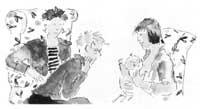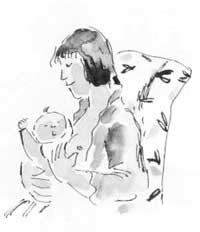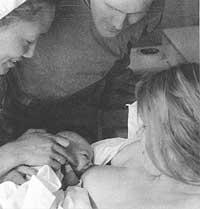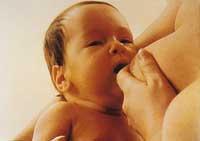Natural lactation: general notions
Nutrition in general is one of the most important factors for the maintenance of health. The concept of “health”, in addition to satisfactory nutrition and absence of disease, includes psychological and social well-being. Therefore, child nutrition is not a mere contribution of urgent nutrients. It is, moreover, a function that demands to ensure the best psychological and social level, and on this last aspect it is necessary that the interaction between the child and the mother is of quality.

There are great reasons to affirm that Natural Lactation is better than any other form of feeding. Lactation is the physiological fulfillment of the reproductive cycle as a function, that is, while it helps to establish a close relationship between the mother and the child, is specially adapted to the nutritional needs of the infant of the first months and contributes to the immunological adaptation to the extrauterine life.
All mammal species produce a special and optimal milk for the growth and development of their offspring. Only the human species has tried to change and replace this stage. Thanks to technological advances, an acceptable biological substitute was developed based on cow's milk, whose first objective was to maintain the life and growth of infants. With the passage of time, as they were getting more and more safe and better milks, these alternatives began to replace Natural Lactation.
But it has been the same nutritional technology, when it has investigated Human Milk, the only one that has shown that breast milk is irreplaceable for the newborn and the infant, and that it is able to cover all the nutritional needs between 5 and 6 months, since in addition to providing the necessary macros and micronutrients, the infant has to provide enzymes, modulators of epidermal growth, anti-infectious defenses and allergy elements. In turn, a hormonal situation occurs in the mother that awakens the maternal feelings and recovers the prenatal physiological environment, that is, inhibiting ovulation, will hinder the immediate return to fertility (an important problem today in the poor countries of the world).

Finally, we will say that Natural Lactation avoids many risks of artificial feeding, especially infection and lack of nutrition in impoverished countries, allergic diseases or discomfort, obesity and occasional metabolic discomfort in rich countries.
At present, biochemists, enzymologists, anthropologists, psychiatrists, pediatricians, nutritionists and professionals of different types of profession coincide in Mother Lactea and underline the value of Natural Lactation. Therefore, pediatricians should assume the axiom recommended by Jelliffe and Jellife and assumed by the “European Society for Pediatric Gastroenteroloy and Nutrition”: “The Breast is Best”, “The breast is better”.
Composition of human milk
The neonatal age and the beginning of childhood are, in nutritional terms, the most critical times of mammals, since in this stage the child will live an unprecedented situation: dependence of a single source of food, milk. It will almost not be possible to compensate with additives any lack of diet. In addition, the growth and development of newborn tissues are fast, so the requirements of essential nutrients are greater and special. In turn, the liver and kidneys of the newborn are immature and food tolerance is more reduced, since these organs are fundamental for the regulation of endogenous metabolism and the elimination of residues.
When we talk about composition the nutritional aspects and especially those related to Macronutrients come to mind (see table "Composition of Human Milk"). It must be taken into account, however, that the micronutrients still unknown are as important as the first, but also the immune properties of Human Milk, that is, the ability to fight infections. In addition, it should be taken into account that the composition of Breast Milk is very variable and varies depending on race and continent. Also in the same mother it is different according to the time of lactation, the time of day or the time of the same period of lactation.

It seems that the toxins we introduce through food or breathing do not reach dangerous concentrations for the child in breast milk. However, chemical contamination is a problem of great concern. As for living organisms, dangerous viruses (the most known, but not the only ones, are the AIDS virus and the hepatitis B virus) can infect the infant with both milk and blood contaminated breast tips. Infection with these viruses is possible to transfer it through Mother's Milk and in HBsAg, HCAg and GIB Ag positive Natural Lactation is not usually recommended, at least in industrialized or rich countries.
The influence of the nutritional state of the mother is very limited in the milk volume and composition. Milk production can only remain completely in very malnourished mothers. The amount of energy consumed by the mother has nothing to do with the composition of milk (except in the pattern of fatty acids). The quality of the maternal diet is also very limited in the composition of your milk.
When we talk about the nutritional needs of the infant, the first thing we have to take into account is that the needs are different depending on the world or the territory, and although it seems to us that a quantity of milk is small, it can be enough for the child of that region. In a specific region, the FAO-WHO organization usually specifies a range of kilocals depending on the weight of the child for each age, and children fed with breast milk did not theoretically meet this energy need, but then it has been shown that this need for energy was excessive (especially in ages between 3 and 6 months) and that natural lactation is sufficient up to 4-6 months.
To verify the latter, it is observed that the weight gain of children fed with Breast Milk is equal to or greater than that of those fed with artificial milk up to 4 months. In a period of between four and six months the weight gain curve decreases and from 6 the weight gain of Natural Lactation receptors decreases. In view of the above, we can ensure that Breast Milk is a good source of nutrition for the first 6 months.
It is necessary to take the beikosta (word used for any food used in feeding the infant other than human milk or formula milk), since pure milk from 6 months in many cases can not cover the needs of energy and can also suppose the lack of other nutrients (iron and vitamin C).

During the second half of breastfeeding, the feeding should be modified through breast milk or formula until the type of diet of the adult is slowly achieved. This change refers to the development of physiological and psychomotor maturity, but it has great importance both cultural and historical factors and the eating habits of the socio-cultural group of infants. The differences are seen in the time and type of entry of the Beikost, within the same region (although it is usual to start entering with 4 months).
It tends to lengthen the duration of pure natural lactation. In 1982, the European Association of Pediatric Gastroenterology and Nutrition (ESPGAN), taking into account the aforementioned cultural and food variation, recommended as a general rule that the beikosta does not enter in less than 3 months or more than 6 months.
Physiology of Lactation
In the group of high level social mammals (primates, human beings, etc. In addition to pure intuition, the behavior learned in the complex relationships between mother and child is of great importance. Society has forgotten this aspect of child growth in developed states.
The beginning of lactogenesis is closely related to the high dimensions of prolactin. This hormone produces special enzymes that are responsible for the protein of milk and the synthesis of lactose. Although in other species of mammals the milk flow continues independently of the measures of prolactin, in the human being it is essential to maintain a high concentration of hormone for its maintenance. The absorption is the highest drag force of prolactin. In traditional societies, breastfeeding or breastfeeding is frequent, and often this lactation is the one that best indicates the relationship between the high measures of prolactin and the long duration of natural lactation.
Both prolactin and estrogens influence the behavior of the mother. Prolactin has a luteotropic effect and its high blood levels eliminate ovulatory cycles. The contraceptive effect of lactation depends on the maintenance of hyperprolactinemia, which often refers to lactation. The latter is very important in traditional societies to extend the gap between pregnancies.

Milk emission is the effect of oxytocin that results from the posterior pituitary in response to the impulses of the hypothalamus; reflex effect. It is activated by the action of the mechanorreceptors of the tip of the chest, oxytocin flows into the blood and acts on the mammary gland and uterus. Consequently, milk is crushed and poured into the milky way.
Training for natural lactation
Mammals begin to grow in the early stages of pregnancy. The pituitary, the corpus luteo and the hormones produced in the placenta create conditions that favor the proliferation of the ductive system and the development of the alveolar structure. By week 16 of pregnancy, milk cells are separated. These cells are the ones that, after pregnancy and the expulsion of lime, cause the production and release of milk by the mammary glands. The outer structure of the mammary glands, nipple and bilgorous glands (Montgomery glands) are also prepared for Natural Lactation.
Normally the mother does not have to do anything to prepare her breasts. If the mother who wants to feed on her milk had a lukewarm nipple or an anatomical variant similar to that of her horse, it should be treated before delivery.
The size of the breasts should not be an obstacle to natural lactation. The nipples or horses in the form of horses should be taken care of before delivery and the tube is the most effective treatment. The tube is applied to the nipple and the aureola 8 weeks or more before delivery. In this way, the soft and continuous pressure that is carried out uniformly along the aureola allows to extract the nipple from the central hole.
It must also be taken into account that the very action of breastfeeding is not pure intuition, nor the encoded behavior. The woman, at birth, does not know how to get married and, if she has not had or has not learned an identification model, does not know when her child is born. This is very common in industrialized societies.
Most mothers and infants do not need special conditions to begin fully in Natural Lactation. Absorption and swallowing have begun when they are in the fetus and it seems that the newborn knows how it is done. Both are coordinated at the time of birth. It is also possible to observe simultaneously the active reflex of mould.

In the act of absorption, the nipple and the aureola are inserted into the child's mouth and become structures like a long tube. The lips and waxing of the infant form the seal to hold the breast, thus contributing to the negative pressure of absorption. The tongue, on the other hand, makes peristaltic movements, that is, through undulations and tears makes the liquid pass through the milk tubes. The bottle tube does not require movement of this type.
When to start breastfeeding?. Recommended shortly after delivery. Once tied the umbilical cord, the baby sitting on the mother's womb will often move looking for his mother's breast. The newborn of apgar (high agility) and non-medicinal is ready to take the breast quickly, carefully. Therefore, put the baby in the chest, preferably in the first 30 minutes. If not possible, it is not advisable to spend more than an hour without putting on the chest and in no case after the first 3 hours.
The reason for its rapid implantation is that the newborn, in addition to eating a paste rich in defense against calories and infections, with its sole presence, produces a stimulus that can increase the fluidity of prolactin, favoring the increase of milk.
The frequency of breastfeeding of the first days depends on the option of the mother and the situation of the child. The best way to regulate natural lactation is flexibility, taking into account the needs of the child and their eating appetite. Specific schedules must be discarded from the beginning. During the first weeks and until the proper amount of milk is applied, the baby will be put for 10 minutes in each burning. In this way a stimulus for both parties is achieved in a few hours, but in this case it should not be very precise either. There are children who only need 5 minutes to empty a chest and others who need 20 minutes or more. In addition, the control of the ammooring measured by clock can prevent the exit of the milk and requires that in the first days it is aspiring for at least 2 minutes to complete the reflection of the casting.
The baby who is taking the breast is already willing to take a new two-hour period. It will progressively prolong the distance between two shots until reaching a minimum sleep of 4 hours daily. The mooring action itself will also change and be shorter and shorter. A child of 2-3 months will be able to remove 80-90% of breast milk in the first 3-4 minutes. However, the baby must be left in the breast until it is full (it can last between 15 and 20 minutes).
The bottle has negative consequences, both for the mother and for the child, since it influences its adaptation and its capacity of milk production, reaching to alter the mother-child relationship. The child fed breast milk does not need water or glucoated after drinking. These additives can only reduce the appetite of the breast. Newborns who drink water lose more weight and recover the lost more slowly.
Once discharged in the hospital, and until a fixed natural lactation (approximately 4 weeks) is achieved, it is not advisable to apply bottles. When there is hypogalactia, “cure” with the bottle can only increase the problem, since the breast is properly discouraged.
Composition of human milk
On macronutrients we can say that their average energy is 70 kilocalories per liter (70 kcal/l), equivalent to cow's milk. Carbohydrates abound, predominantly lactose. It is probably due to the need for energy for the growth of the brain and the absorption of calcium and other minerals.
The protein content is suitable for infant growth. In this way, the appearance of remains that would cause excessive work for the kidneys and liver is avoided. Human milk is the milk studied with a lower concentration of proteins. It is very important the lack of allergenicity of the proteins of Breast Milk (especially in the first months of life), since the intestine of the child is permeable to the protein macromolecules that can produce an immunological reaction. Another peculiarity of Human Milk is its high content in non-protein nitrogen (25% of the total nitrogen and present in more than 200 substances). As with many other substances, we do not know well what their function is, but it indicates that their proportion is important.

Lipids provide the organism with precursors fatty acids of the protagonist, fat-soluble vitamins, sterols and phospholipids. It is worth mentioning the high concentration of unsaturated fatty acids of breast milk, mainly oleic and linoleic, while saturated is very scarce. Great importance are acquiring the Long Chain Polyunsaturated Fatty Acids (KL-GAPIs). It seems that they are essential in the structure of the system of membranes, in the phospholipids of the Central Nervous System and in the structure of the photoreceptor cells of the network. These CL-GAPI contain adequate concentrations, as is the case with artificial milks, which can produce insufficiency in structural lipids.
Human Milk has a very low mineral concentration (such as calcium and fossils), but with many mechanisms its absorption is adequate and sufficient to mineralize the skeleton. Iron is also scarce, but it absorbs between 50-70% for lactopherrin, when in any other compound it does not pass 30%. As for vitamins, we can say that when the mother is well nourished, the infant fed with Mother's Milk is very difficult to stay in lack of vitamin, with the exception of vitamin D and vitamin K (the latter when natural lactation begins late). In addition, enzymes for the maintenance of milk in Human Milk, proteolytic enzymes, hormones, etc. appear.
But in addition to the macroaccessories mentioned, other molecules have been differentiated: The so-called Moderator Growths. They are small fractions of milk, low molecular weight substances (such as taurine) and hormone-like substances. They appear to be of great importance in children with growth problems. Of course, Artificial Milks do not contain these microaccessories.
However, despite the fact that some nutritional supplements of Human Milk have been produced (and as we have said, the industry is still far from reaching a specific composition), which today is impossible to produce its protection capacity against infections. Human Milk has a very important content in the immunological factors (which will combat the infections of its species, of course) and the milk of other species, or the products obtained from it do not have it. Antibodies stand out against some internal organisms, immunoglobulins, lysozima, laktoferrin and macrophages.
Among the immunoglobulins, Immunoglobulin Fluid A (Ig A-J) is the most important, while in cow's milk are Ig G and Ig M. It is synthesized in the mammary gland and its daily amount is stable during all stages of lactation. Ig A-J acts against many viruses and bacteria. It is of great importance in the first bacterial colonization of the newborn intestine, blocking the adhesion of bacteria to the epithelium. In addition, Ig A-J stops enterotoxins and prevents the absorption of antigens in food. This last mechanism explains why there is less allergy to infants fed by Natural Lactation.
Another peculiarity in Human Milk is its high content in lactopherrin, with a protein of dairy serum of 10-25%. This substance shows exactly the difference and interaction between the nutritional and physiological role of the proteins of Human Milk. This role of laktoferrin can be summarized in 3 points: the nutritional influence (responsible for the great utility of iron), the antimicrobial (obtaining iron does not allow to release from this metal nothing necessary for microbial growth) and the mitogenic and trophic influence of the intestinal mucosa.
But among the substances that we can find in Breast Milk are others that have no influence neither on nutrition nor on the defense of the organism. For example, some maternal hormones can be released through milk, but their concentration will never be dangerous for infants, at least while they are physiological. There are other non-physiological substances that flow in Breast Milk. For example, ethanol (alcohol) has the same concentration in milk as in maternal plasma. Although many of the medications the mother can take are found in milk, we should always take into account tolerance to the child's medications (especially in the first weeks), since the intestinal epithelium is very permeable. And we always have to keep in mind the following question: Is medication essential for the mother?





